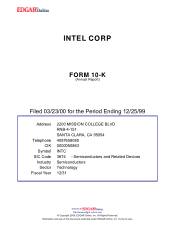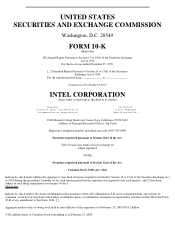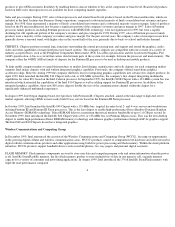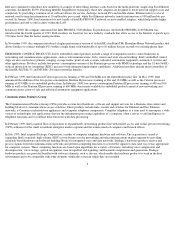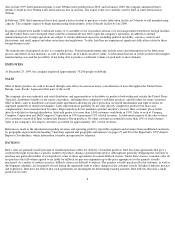Intel 1999 Annual Report Download - page 5
Download and view the complete annual report
Please find page 5 of the 1999 Intel annual report below. You can navigate through the pages in the report by either clicking on the pages listed below, or by using the keyword search tool below to find specific information within the annual report.Intel Architecture Business Group
The Intel Architecture Business Group (IABG) tailors platform solutions around Intel's microprocessors and chipsets for all major computing
segments worldwide, using a tiered branding approach. Intel's strategy is to provide both the highest performance and the best value through a
broad range of microprocessor and chipset solutions that power the client and server market segments. Client platforms incorporate IABG
products in desktop computers, notebooks, entry- level servers and workstations, and Internet appliances. Server platform products are targeted
for mid-range to high-end servers and workstations. Servers are powerful systems, often with multiple microprocessors working together,
housing large amounts of data, directing traffic, and controlling central functions in local and wide area networks and on the Internet.
Workstations offer higher performance than standard desktop PCs, especially with respect to graphics, processing power and the ability to carry
out several tasks at the same time.
The IABG products include processors based on the P6 microarchitecture
(including the Intel(R) Celeron(TM), Pentium(R) III and Pentium(R) III Xeon(TM)
processors) and related board- and system-level products. In addition, the core-logic chipset products within IABG provide features improving
ease of use, providing new capabilities and enabling system performance to scale as the processor performance increases.
MICROPROCESSORS. A microprocessor is the central processing unit of a computer system. It processes system data and controls other
devices in the system, acting as the brains of the computer. The rate at which a microprocessor's internal logic operates, called its clock speed,
is measured in units of hertz or cycles processed per second. One megahertz (MHz) equals one million cycles processed per second, and one
gigahertz (GHz) equals one billion cycles processed per second. The memory stored on a chip is measured in bytes, with 1,024 bytes equaling a
kilobyte (KB), 1.049 million bytes equaling a megabyte (MB) and 1.074 billion bytes equaling a gigabyte (GB). Cache is a memory subsystem
in which frequently used data is duplicated for quick access. A second level of cache (L2), located directly on the microprocessor, can also be
used to further increase system performance.
Intel's developments in the area of semiconductor design and manufacturing have made it possible to decrease the size of circuits etched into
silicon, permitting a greater number of transistors to be used on each microprocessor die, and a greater number of microprocessors to be placed
on each silicon wafer. The result is smaller, faster microprocessors that consume less power and cost less to manufacture. The length of the
individual transistors on a chip is measured in microns; one micron equals one millionth of a meter. In 1999, Intel began converting its
microprocessor manufacturing to the 0.18-micron process technology.
In 1999, Intel announced several new microprocessor products aimed at the various computing market segments ranging from value PCs
(systems costing less than $1,000) to high-performance workstations and servers.
Value PCs. Tailored for the value PC market segment, the Intel Celeron processor meets the core computing needs and affordability
requirements common to many new PC users. From January 1999 to August 1999, Intel introduced several new higher speed versions of the
Intel Celeron processor running at speeds ranging from 366 MHz to 500 MHz. In January 2000, Intel introduced a 533-MHz version of the
Intel Celeron processor. All of these Celeron processors have 128 KB of integrated L2 cache on the processor core.
Performance desktop PCs. In February 1999, Intel introduced the Pentium III processor. Targeted for the performance desktop personal
computer and low-end server and workstation market segments, the Pentium III processor is designed specifically to enhance the Internet
experience and offers high performance and enhanced multimedia realism for Internet applications. The Pentium III processor includes Internet
Streaming SIMD Extensions, 70 new instructions that enhance the performance of advanced imaging, 3D graphics, streaming audio, video and
speech recognition applications. The 450- and 500-MHz versions, with 512 KB L2 cache, began shipping in March 1999; the 550-
MHz version
was introduced in May 1999; and the 600-MHz version was introduced in August 1999.
In October 1999, the company introduced new versions of the Pentium III processor built on the 0.18-micron process technology, all
integrating 256 KB of L2 Advanced Transfer Cache; these processors run at speeds of up to 733 MHz. With Advanced Transfer Cache, the
path between the processor and L2 cache memory is wider, creating better performance than previous Pentium III processors running at the
same clock speed. The Advanced Transfer Cache enables application performance to scale with increasing clock frequencies. In December
1999, Intel
2

